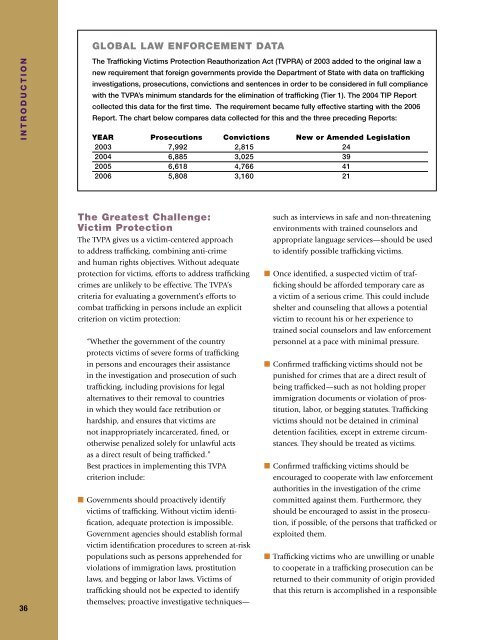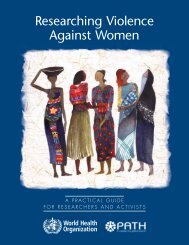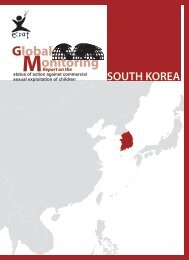2007 Trafficking in Persons Report - Center for Women Policy Studies
2007 Trafficking in Persons Report - Center for Women Policy Studies
2007 Trafficking in Persons Report - Center for Women Policy Studies
Create successful ePaper yourself
Turn your PDF publications into a flip-book with our unique Google optimized e-Paper software.
GLOBAL LAW ENFORCEMENT DATA<br />
I N T R O D U C T I O N<br />
The <strong>Traffick<strong>in</strong>g</strong> Victims Protection Reauthorization Act (TVPRA) of 2003 added to the orig<strong>in</strong>al law a<br />
new requirement that <strong>for</strong>eign governments provide the Department of State with data on traffick<strong>in</strong>g<br />
<strong>in</strong>vestigations, prosecutions, convictions and sentences <strong>in</strong> order to be considered <strong>in</strong> full compliance<br />
with the TVPA’s m<strong>in</strong>imum standards <strong>for</strong> the elim<strong>in</strong>ation of traffick<strong>in</strong>g (Tier 1). The 2004 TIP <strong>Report</strong><br />
collected this data <strong>for</strong> the first time. The requirement became fully effective start<strong>in</strong>g with the 2006<br />
<strong>Report</strong>. The chart below compares data collected <strong>for</strong> this and the three preced<strong>in</strong>g <strong>Report</strong>s:<br />
YEAR Prosecutions Convictions New or Amended Legislation<br />
2003 7,992 2,815 24<br />
2004 6,885 3,025 39<br />
2005 6,618 4,766 41<br />
2006 5,808 3,160 21<br />
36<br />
The Greatest Challenge:<br />
Victim Protection<br />
The TVPA gives us a victim-centered approach<br />
to address traffick<strong>in</strong>g, comb<strong>in</strong><strong>in</strong>g anti-crime<br />
and human rights objectives. Without adequate<br />
protection <strong>for</strong> victims, ef<strong>for</strong>ts to address traffick<strong>in</strong>g<br />
crimes are unlikely to be effective. The TVPA’s<br />
criteria <strong>for</strong> evaluat<strong>in</strong>g a government’s ef<strong>for</strong>ts to<br />
combat traffick<strong>in</strong>g <strong>in</strong> persons <strong>in</strong>clude an explicit<br />
criterion on victim protection:<br />
“Whether the government of the country<br />
protects victims of severe <strong>for</strong>ms of traffick<strong>in</strong>g<br />
<strong>in</strong> persons and encourages their assistance<br />
<strong>in</strong> the <strong>in</strong>vestigation and prosecution of such<br />
traffick<strong>in</strong>g, <strong>in</strong>clud<strong>in</strong>g provisions <strong>for</strong> legal<br />
alternatives to their removal to countries<br />
<strong>in</strong> which they would face retribution or<br />
hardship, and ensures that victims are<br />
not <strong>in</strong>appropriately <strong>in</strong>carcerated, f<strong>in</strong>ed, or<br />
otherwise penalized solely <strong>for</strong> unlawful acts<br />
as a direct result of be<strong>in</strong>g trafficked.”<br />
Best practices <strong>in</strong> implement<strong>in</strong>g this TVPA<br />
criterion <strong>in</strong>clude:<br />
n Governments should proactively identify<br />
victims of traffick<strong>in</strong>g. Without victim identification,<br />
adequate protection is impossible.<br />
Government agencies should establish <strong>for</strong>mal<br />
victim identification procedures to screen at-risk<br />
populations such as persons apprehended <strong>for</strong><br />
violations of immigration laws, prostitution<br />
laws, and begg<strong>in</strong>g or labor laws. Victims of<br />
traffick<strong>in</strong>g should not be expected to identify<br />
themselves; proactive <strong>in</strong>vestigative techniques—<br />
such as <strong>in</strong>terviews <strong>in</strong> safe and non-threaten<strong>in</strong>g<br />
environments with tra<strong>in</strong>ed counselors and<br />
appropriate language services—should be used<br />
to identify possible traffick<strong>in</strong>g victims.<br />
n Once identified, a suspected victim of traffick<strong>in</strong>g<br />
should be af<strong>for</strong>ded temporary care as<br />
a victim of a serious crime. This could <strong>in</strong>clude<br />
shelter and counsel<strong>in</strong>g that allows a potential<br />
victim to recount his or her experience to<br />
tra<strong>in</strong>ed social counselors and law en<strong>for</strong>cement<br />
personnel at a pace with m<strong>in</strong>imal pressure.<br />
n Confirmed traffick<strong>in</strong>g victims should not be<br />
punished <strong>for</strong> crimes that are a direct result of<br />
be<strong>in</strong>g trafficked—such as not hold<strong>in</strong>g proper<br />
immigration documents or violation of prostitution,<br />
labor, or begg<strong>in</strong>g statutes. <strong>Traffick<strong>in</strong>g</strong><br />
victims should not be deta<strong>in</strong>ed <strong>in</strong> crim<strong>in</strong>al<br />
detention facilities, except <strong>in</strong> extreme circumstances.<br />
They should be treated as victims.<br />
n Confirmed traffick<strong>in</strong>g victims should be<br />
encouraged to cooperate with law en<strong>for</strong>cement<br />
authorities <strong>in</strong> the <strong>in</strong>vestigation of the crime<br />
committed aga<strong>in</strong>st them. Furthermore, they<br />
should be encouraged to assist <strong>in</strong> the prosecution,<br />
if possible, of the persons that trafficked or<br />
exploited them.<br />
n <strong>Traffick<strong>in</strong>g</strong> victims who are unwill<strong>in</strong>g or unable<br />
to cooperate <strong>in</strong> a traffick<strong>in</strong>g prosecution can be<br />
returned to their community of orig<strong>in</strong> provided<br />
that this return is accomplished <strong>in</strong> a responsible
















